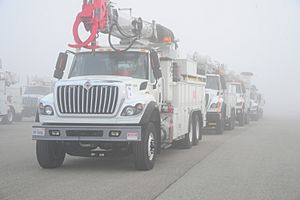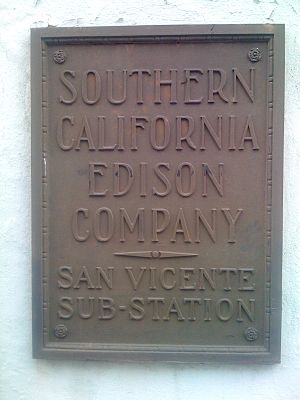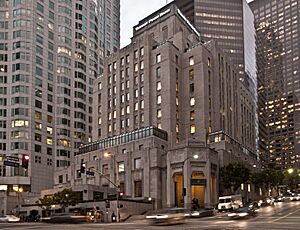Southern California Edison facts for kids
 |
|
| Subsidiary | |
| Industry | Electric utilities |
| Headquarters | 2244 Walnut Grove Ave., Rosemead, CA 91770 |
|
Area served
|
Central, Coastal & Southern California |
|
Key people
|
Steven D. Powell (CEO) |
| Products | Electricity generation Electric power transmission Electric power distribution |
| Revenue |
|
|
Operating income
|
|
|
|
|
Number of employees
|
|
| Parent | Edison International |
Southern California Edison (SCE) is a big company that provides electricity to many homes and businesses in Southern California. It's the largest part of a bigger company called Edison International. SCE delivers power to about 15 million people across a huge area of 50,000 square miles.

SCE owns all the equipment used to send electricity over long distances. In the late 1990s, California changed its electricity rules. This meant SCE had to sell many of its power plants. However, SCE kept its hydroelectric plants, which use water to make power. They also kept their share of the San Onofre Nuclear Generating Station. This nuclear plant stopped making power in 2012 and is now being taken apart.
Besides electricity, SCE also runs the only gas and water companies on Santa Catalina Island. These are called Catalina Island Gas Company and Catalina Island Water Company.
Contents
How Southern California Edison Started
Southern California Edison began with a big idea around 1908. A businessman named Henry E. Huntington and an engineer named John S. Eastwood planned to build many reservoirs in the Sierra Nevada Mountains. These reservoirs would help create a huge system to make electricity from water power.
Huntington started a company called Pacific Light and Power to build this system. It became one of the largest hydropower systems in the United States. Pacific Light and Power, along with other companies like Edison Electric, later joined to form Southern California Edison.
How SCE Gets Its Energy
Power from Renewable Sources
Southern California Edison lets its customers choose to get all their electricity from clean, renewable sources. This is called a "green rate."
In 2006, SCE planned to get a lot more power from new projects. These projects were built in the Tehachapi Pass Wind Farm area. This plan more than doubled the amount of wind energy SCE used. It included over 50 square miles of wind parks, which is much larger than any other wind farm in the U.S. at the time.
In 2008, SCE announced a big project to build a network of photovoltaic solar power plants. This was the largest solar cell project in the nation. The solar cells cover 65 million square feet of rooftops in Southern California. They make enough power for 162,000 homes.
SCE also signed agreements to buy solar thermal power. This technology uses mirrors to focus sunlight and create heat. This heat is then used to make electricity. One project planned to use a special "dish Stirling system." This system uses reflective dishes and a heat engine to turn heat into electricity. However, this project was canceled because solar panel technology became cheaper.
In 2014, SCE installed the Tehachapi Energy Storage Project. This project uses over 600,000 lithium-ion battery cells. It helps store power from the Tehachapi area, which has 5,000 wind turbines.
By 2016, about 28.2% of SCE's power came from renewable sources.
Natural Gas and Energy Storage
In 2017, SCE opened two new power plants that combine gas turbines with large batteries. These are called "peaker plants." Each plant can provide about 50 megawatts of power. The batteries can give 10 megawatts of power for four hours. Both the turbines and batteries are made by General Electric.
These plants use the battery power first for short bursts of electricity. This saves natural gas for when power is needed for longer periods. Using batteries with gas turbines helps the environment. This setup by SCE has reduced greenhouse gas emissions by 60%. It also cut water use by 2 million gallons each year and lowered the number of times the gas turbines need to start by half.
Connecting Power Grids
Southern California Edison's power grid is connected to other power systems in California. These connections help move electricity around the state. They also link to power grids in other states, like those in the Pacific Northwest.
SCE's Policies and Programs
Helping Electric Vehicles
Southern California Edison offers special programs and electricity rates for people who own electric vehicles (EVs).
By July 2018, SCE planned to add thousands of new charging stations for passenger EVs. This was part of their "Charge Ready" program. This program aims to make more charging spots available for electric vehicles.
Since 2016, Southern California Edison has installed 1,000 charging stations. These are located across their service area in Southern and Central California.
The company also has a program that gives money back to people who buy electric vehicles.
Energy Research and Ideas
Southern California Edison has a long history of researching energy. They often work with other companies and government groups. One example was the SOLARII project. This was a solar-powered energy plant that could make electricity 24 hours a day. It did this by heating special salts that would store heat during the day. This stored heat could then be used to make power at night.
SCE also works on policies related to oil, gas, and electricity. They also look into rules for greenhouse gas emissions.
In 2014, SCE announced a partnership to store energy more efficiently. This involved freezing water at night when electricity is cheaper.
Employee Practices
In 2015, Southern California Edison laid off about 400 of its IT (Information Technology) employees. They also hired workers from India through other companies. The US Department of Labor looked into this to see if SCE followed all the rules.
Wildfires and Lawsuits
Wildfires are a big problem in California. Some major wildfires have been caused by Southern California Edison’s equipment.
Responsibility for Fires
California law says that if a fire is caused by a utility company’s electrical equipment, the company is responsible for the damages. This is true even if they didn't mean to cause the fire. In July 2019, California created a $21 billion fund to help pay for damage from future wildfires. This fund helps cover costs, and it also changed how utility companies are held responsible for fires.
The Calabasas Fire (1996)
The Calabasas Fire happened in October 1996. It burned over 13,000 acres and destroyed six buildings. Investigators found that Edison’s equipment had started the fire. After the fire, Edison and the government agreed on how to handle future wildfire investigations.
The Creek Fire (2017)
The Creek Fire burned in Los Angeles from December 2017 to January 2018. It destroyed 123 buildings.
At first, another company was thought to be responsible. However, new information showed that an electrical problem on SCE's equipment happened when the fire started. A federal investigator then concluded that SCE’s equipment caused the Creek Fire. The government is now suing SCE for causing the fire and for not providing all the information earlier. SCE says they did not start the fire and that any missing information was a mistake.
The Thomas Fire (2017-2018)
The Thomas Fire burned in Ventura County and Santa Barbara from December 2017 to January 2018. It destroyed over 1,000 buildings and caused two deaths. The fire also made the soil unstable, leading to mudslides that killed 23 people and destroyed over 100 homes. An investigation found that Edison’s equipment was responsible for starting the Thomas Fire. Edison paid over $2.7 billion to settle claims related to the fire and mudslides.
In January 2025, a state commission approved SCE’s request to raise electricity rates. This was to help cover over $1.6 billion in payments to Thomas Fire victims. Many people in Los Angeles were against this. They argued that customers should not have to pay for Edison’s mistakes. Edison said that while their equipment caused the fire, they were not careless. They also said they would spread the costs over 30 years to make it easier on customers.
The Woolsey Fire (2018)
The Woolsey Fire burned in Los Angeles County and Ventura County in November 2018. It destroyed 1,643 buildings and caused three deaths. In 2020, a state report concluded that Edison’s electrical equipment caused the fire. Edison later paid $2.2 billion to settle claims related to this fire.
The state’s Department of Justice looked into whether to file charges against SCE. They decided not to, finding that while SCE’s equipment and poor tree trimming led to the fire, it was not a criminal act.
The Eaton Fire (2025)
The Eaton Fire burned in the Eaton Canyon of the San Gabriel Mountains in January 2025. It spread into nearby communities like Altadena. This fire caused 18 deaths and destroyed over 9,000 buildings. This made it the second most destructive wildfire in California history.
The cause of the Eaton Fire is still being investigated. However, witnesses and videos have linked it to Edison’s power lines in Eaton Canyon. Edison also reported that a problem on its lines happened around the time the fire started. The Los Angeles Times reported that regulators had criticized Edison for not inspecting power lines in high-risk areas enough. They also criticized Edison for checking wind speed less often than other utility companies.
Edison has pointed to the work they have done to reduce wildfire risk. They also suggested that a nearby homeless camp might have started the fire. They believe they acted carefully, even if their lines were involved. Some fire victims have sued SCE. They claim the company was careless and did not turn off power safely. Los Angeles County, Pasadena, and Sierra Madre have also announced plans to sue Edison.
NPR reported that while the fire was burning, Edison turned power lines back on. This happened even though firefighters asked them to keep the power off. This caused downed power lines to spark new fires.
Other Fires
Edison’s equipment has also been found to cause other fires. These include the 2007 Malibu Canyon Fire, Liberty Fire, Meyers Fire, Rye Fire, Easy Fire, Bobcat Fire, Silverado Fire, Coastal Fire, and the Fairview Fire. It may also have caused the Hurst Fire and the Eaton Fire.
See also
- Energy use in California
- Solar power plants in the Mojave Desert
- Wind power in California
- List of articles associated with nuclear issues in California



